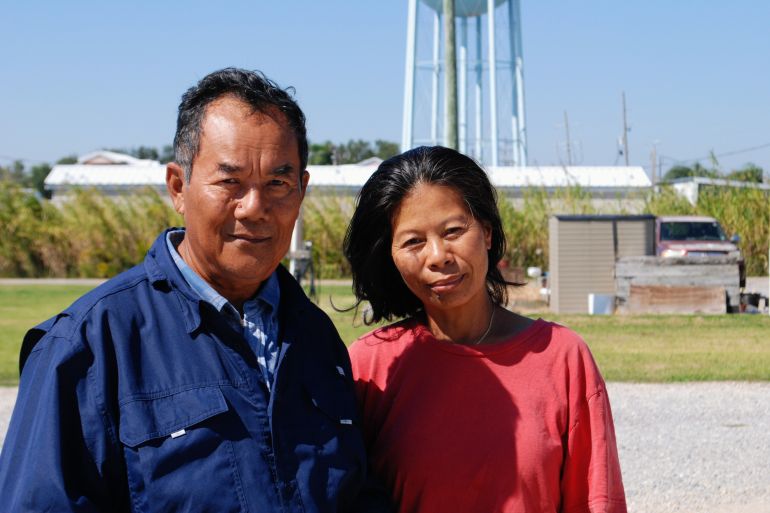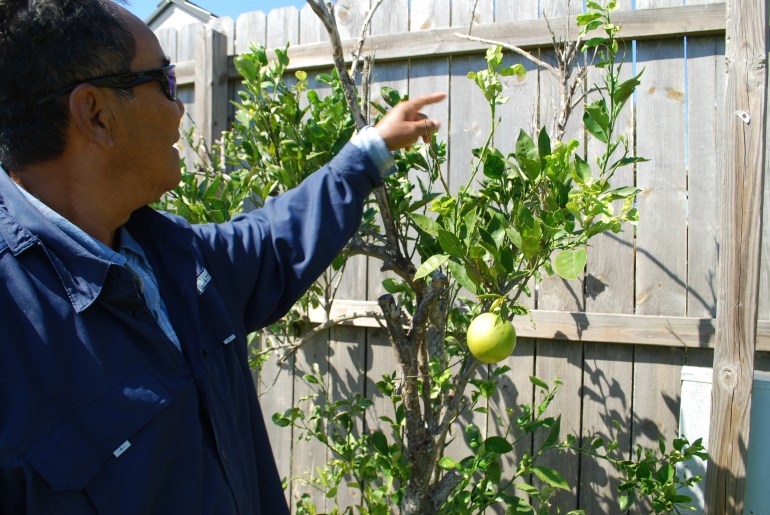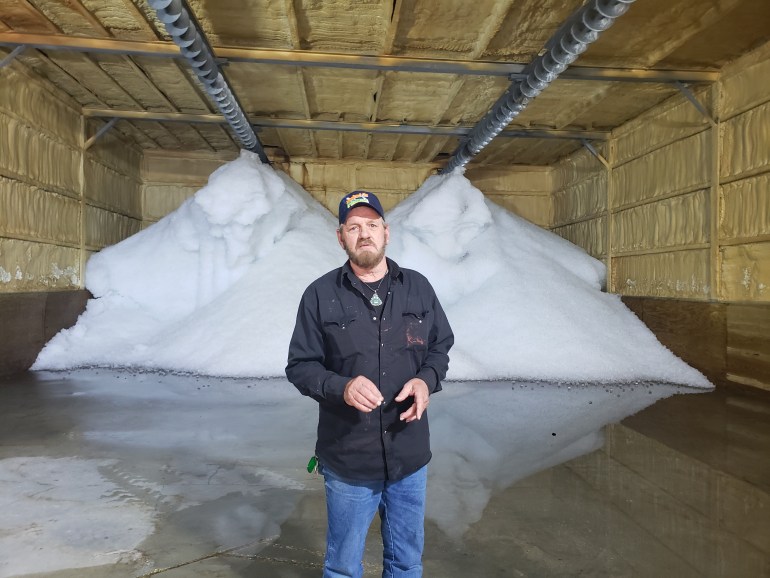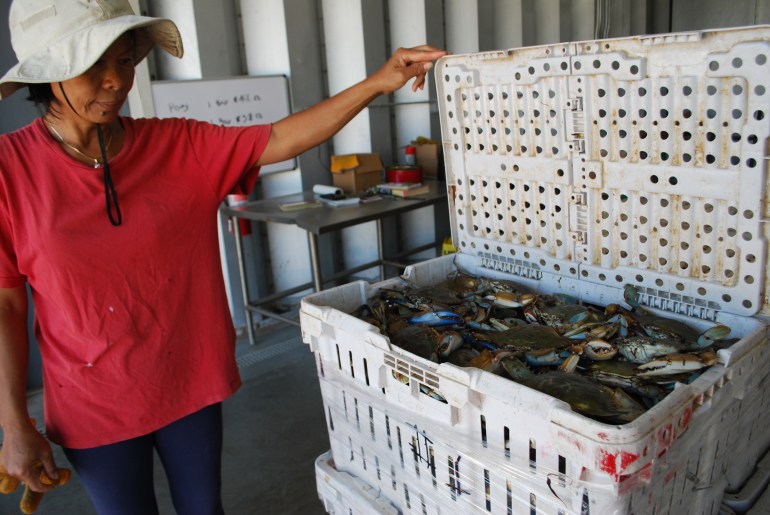Salt in paradise: What a Louisiana crabber is losing to saltwater intrusion
Drought has allowed sea water to advance up the Mississippi River, putting drinking water and other resources at risk.

New Orleans, Louisiana – On a thin strip of land that winds along the Mississippi River, crabber James Kim gently touches his last surviving orange tree. It’s a warm, clear October afternoon, but the tree’s fruit is marred by soft green spots.
“We planted 20 of them,” says Kim, gesturing behind him to the empty row where trees once stood at the back of his garden. For about eight years, he says, they bore good oranges. “Then, later on, the weather changed. Everything salty, salty. And they all died.”
Keep reading
list of 3 itemsWho is Mike Johnson, the new US Republican House speaker?
US sees record number of ‘billion-dollar’ disasters so far this year
Since June, seawater from the Gulf of Mexico has nosed up the Mississippi River, helped by extreme drought and sea level rise. In Louisiana’s lower Plaquemines Parish, where Kim lives, this saltwater intrusion has sparked a crisis.
For months, more than 9,000 residents have been left without safe drinking water. And while parish officials say the water is now potable again — thanks to the recent installation of reverse osmosis machinery — in the river, the salt remains.
The parish’s proximity to wetlands and the Gulf means it is acutely vulnerable to climate change. Plaquemines Parish could lose more than half its land area over the next 45 years, as the seas rise and the marshes erode.
And while the crabs are happy enough in the saltier river, saltwater intrusion threatens to squeeze an industry already facing collapse.
The small towns here comprise one of the United States’ largest seafood ports. But just last month, Louisiana Governor John Bel Edwards requested an emergency declaration for shrimpers struggling in the face of imports and plummeting prices.
Now, the advancing saltwater is transforming the coastal environment, burning the roots of cypress trees and pushing freshwater species upstream, disrupting local fisheries.
The problem of salt is not entirely new: Kim’s garden mostly died amid saltwater intrusion issues in 2021. But this year, the seawater has come further and stayed much longer than usual.
“When there’s no salt and the weather is good,” Kim says, “normally, it’s paradise”.

Chickens, crabs and passionfruit
Kim arrived in the US from Cambodia in 1989. At first, he hopped around the country chasing work — travelling from Alabama to Massachusetts, where he and his wife, Karen Suon, processed sea urchins — before settling in Louisiana in 2005.
Kim and Suon are the only two employees of J&K World Trade, a company that processes crabs to sell to wholesalers and factories. They work “seven days a week”, says Suon, cleaning and sorting thousands of crabs that fishers haul in from the wetlands nearby.
When a refrigeration truck pulls up, Suon, dressed in white shrimper boots and a floppy wide-brimmed hat, pulls a pallet jack into their giant industrial cooler.
She emerges with two dozen bushels of live blue crabs, who sleepily poke their pincers through the boxes’ holes. Kim drives a small forklift to load the crab boxes into the back of the waiting truck so they can be transported to wholesalers.
But he pauses to point to a large splotch of reddish brown on his forklift: rust.
“We ordered a new one,” Kim shouts over the noise of idling engines. The machinery here typically rusts due to the salt in the air, a normal phenomenon for the coastal parish. But lately, the rust has accelerated dramatically. The replacement will cost the couple about $43,000, says Suon, laughing as she winces.
Machines can be replaced. But as salt increasingly pushes upriver, it is also killing plants across the parish.
“All the plants and everything [are] gone,” Kim says.
Kim walks back towards his garden, a collection of coops and planters he built himself from wood and aluminium siding. He plucks fragrant leaves from Thai basil and tarragon, pointing out passionfruit and grape vines and bitter melons. He also grows several different plants used to make traditional Cambodian medicine, to ward off illness and increase circulation.
He also has over 100 chickens: It gets lonely down here, he jokes, as they peck at the empty crab shells. He freely shares the bounty from his harvests — fruit, eggs, meat, medicine — with his neighbours. The community here is close-knit.
But in recent years, he has less to share. The garden used to be much bigger, he explains, but salt killed most of his plants. During the hot Louisiana summer, he had to purchase the five gallons (19 litres) of freshwater his chickens needed each day.

More salt, less ice
At Ditcharo Seafood in Buras, part of the Plaquemines Parish, dock manager Mike Berthalot opens an enormous metal cabinet and points inside.
There, water runs over huge tubes of freon. Suddenly, before Berthalot’s eyes, the water blooms white with ice, freezes and finally sloughs off in a clatter, falling into an enormous metal container in the dock below.
But something is wrong with Berthalot’s ice machines. At the top, the tubes are turning yellow.
Berthalot says that’s due to salt. “It’s really messing everything up.”
These million-dollar machines are crucial for the shrimp docks, which use massive caches of ice to fill boat holds and cool the nearly 226,796 kilogrammes (500,000 pounds) of shrimp the dock receives each day.
And water valves are breaking, too. “We buy them brand-new, and they’re only lasting not even two months,” Berthalot says. “Every one of them’s gone bad on me.”
Berthalot, a flurry of hectic activity who speaks with gruff warmth, is a self-taught repairman. He’s worked these docks for over 45 years. Some repairs, he can handle, but for major breaks, his company needs to fly in a specialist from Georgia — a burdensome expense. A few weeks ago, Berthalot says, they had to spend $20,000 on repairs.
He’s never seen ice machines have issues like this, he adds.
Since July, the machines have been producing about half of what they should, forcing the company to buy ice out of pocket. Derek Ditcharo, the owner’s brother, estimates the company has spent $50,000 on ice due to problems with the machines.

Small farmers most vulnerable
Many workers at the Ditcharo dock are, like Kim, East Asian. Sandy Nguyen of Coastal Communities Consulting, a language access group for Asian fishers, estimates that 50 to 60 percent of people in lower Plaquemines are East Asian, primarily Vietnamese and Cambodian.
“The saltwater intrusion has impacted them a lot,” says Nguyen. “It’s really bad.”
And as the sea-level rise accelerates and weather events grow more extreme, saltwater intrusion is expected to worsen in future years. Already, the smaller, more vulnerable farmers and fishers are feeling the brunt of the problem, with fewer resources to adapt to the saltier environment.
Fifty miles upriver in Belle Chasse, just past the farthest reach of the saltwater, Ricky Becnel, one of the country’s leading citrus producers, pauses his Gator utility vehicle at the top of a levee.
On one side sprawl 10,000 fruit trees: acres of red pineapple, persimmons, olives and figs. On the other side, a pipe plunges down into the river, sucking up 120,000 gallons (450,000 litres) per day, to be filtered through an automated $50,000 irrigation system.
Becnel got the system 21 years ago, when he faced “a similar situation — not quite this severe”. The filter doesn’t remove salt, but so far he’s OK. The salt here isn’t as bad as down in Boothville, the community where Kim lives.
In fact, from the levee, Becnel can see ships dredging river mud to build an underwater sill, meant to hold back the salt. The US Army Corps of Engineers is leading the project, part of a multi-pronged effort to address the threat. Currently, the Army Corps predicts that the salt will reach Becnel’s farm in November.
Hopes pinned on a well
But Kim fears the parish is not adequately planning for a long-term solution.
He has considered digging his own well. It would cost up to $4,000 but would be sufficient to water his crops, since he has a much smaller operation than Becnel.
Kim, however, doesn’t think the parish will give him a permit to dig it. For now, he and Suan are still getting bottled water from the nearby fire station for drinking and cooking.
And the dragon fruit, at least, are still growing strong.
He points out the bright-green cactus they grow on, which he’s nursed on blue crab shells, crushed up and mounded around the plant’s base once a year. The crab shells help the last of his dragon fruit trees grow “quick and all natural and very sweet”, he says proudly. “Very sweet.”